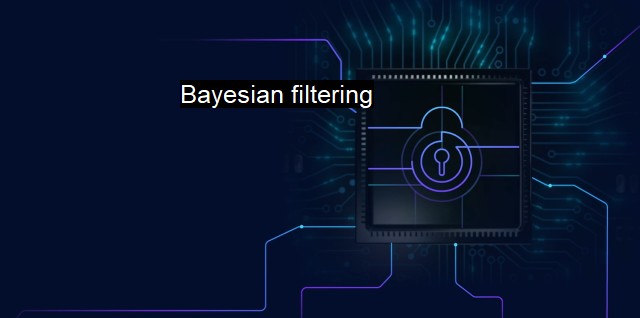What is Bayesian filtering?
The Importance of Bayesian Filtering in Cybersecurity and Antivirus: A Statistical Approach to Preventing Email Spoofing and Spamming
Bayesian filtering is a statistical method used prevalently in the cybersecurity landscape, specifically in email spam filtering, malware detection, and attack prediction scenarios. Named after Thomas Bayes, who proposed the theorem that the technique relies on, Bayesian filtering is used in developing intelligent algorithms that distinguish potentially harmful content or behavior from harmless ones.Bayesian filtering operates like a probability machine: it calculates the likelihood of an event based on the weighted sum of circumstances surrounding that event. It does not merely look at an event in isolation, but also considers the surrounding factors or preceding events and makes projections based on the entirety.
A classic application of Bayesian filtering is email spam detection. When you receive an email, your email client, with a Bayesian filter implemented, does not only look at the content of that email, but it also considers the sender's name, the presence of attachments, and even things like the time sent. Each of these factors is given a probability weight and the overall conclusion is reached by calculating the sum of these probabilities. If the sum exceeds a predetermined threshold, then the email may be classified as spam and subsequently gets redirected to the junk file.
Likewise, this approach can be instrumental in the context of malware detection in antivirus programs. Once a computer or network behavior is observed deviating from the usual pattern or performing suspicious actions like attempting unauthorized data modification or transmission, the Bayesian filter can determine whether such a behavior aligns with known malware behavior patterns.
In this case, the Bayesian filter works by classifying the observed behavior's similarity to known examples of malware-related behavior. The antivirus software compares the observed behavior’s various characteristics with known malware behavior, including its nature, frequency, and severity. Each attribute is assigned a probability, based on their occurrence in past examples of malware attacks. A higher total probability means a higher likelihood that the software is interacting with malware, prompting appropriate countermeasures.
One of the advantages of Bayesian filtering is its capability to continuously learn and adjust based on new data insights. This feature makes it a much more robust and adaptive tactic, distinguishing it from other more static identification algorithms. In a rapidly evolving field like cybersecurity, with persistently advancing threats, the potency of adaptive systems such as Bayesian filters is immense.
Yet, like all cybersecurity tactics, Bayesian filtering is not exempt from limitations. A significant challenge in Bayesian filtering methods is the need for a comprehensive and accurate spam or malware base for analysis. Limited or skewed historical data can affect the effectiveness of spam or malware detection.
Despite these limitations, Bayesian filtering has proven instrumental in many areas of cybersecurity. Its flexibility to adapt to the dynamics of evolving threats makes it a reliable line of defense against malicious activity. its systematic filtering capability helps ensure that normal, benign activities do not get caught unnecessarily in the cybersecurity net, thereby optimizing system performance.
Bayesian filtering, coupled with other cybersecurity measures, aids in protecting computing networks from assorted threats while maintaining high operational productivity. Its integration into many popular spam filters and antivirus software testifies to both its functionality and its potential for aiding in the preservation of cybersecurity. In this era of rampant cyber threats and attacks, implementations such as Bayesian filtering are ever more critical for maintaining robust digital defense systems.

Bayesian filtering FAQs
What is Bayesian filtering?
Bayesian filtering is a statistical technique used to classify and filter incoming data based on probabilities. It uses Bayes' theorem to calculate the probability of an event or message being spam or legitimate based on the frequency of certain words or phrases in the message. This technique is commonly used in cybersecurity and antivirus programs to filter out malicious emails and prevent them from reaching the user's inbox.How does Bayesian filtering work in antivirus programs?
In antivirus programs, Bayesian filtering works by analyzing the content of incoming email messages and assigning a score based on the probability of the message being spam or legitimate. The filter will then quarantine or delete messages that exceed a certain threshold score. The filter learns from the user's behavior and email history and becomes more accurate over time.What are the benefits of Bayesian filtering in cybersecurity?
Bayesian filtering has several benefits in cybersecurity, including providing accurate filtering of spam and malicious messages, reducing the risk of phishing attacks, and improving the overall security of the network. It also helps to improve the efficiency of antivirus programs and reduces the amount of time and resources needed to manually filter out unwanted messages.Are there any limitations to Bayesian filtering in antivirus programs?
While Bayesian filtering is an effective technique for identifying and filtering out malicious messages, it is not perfect and can produce false positives and false negatives. Additionally, sophisticated attackers may be able to bypass the filter by using techniques such as obfuscation or encryption. It is important for users to remain vigilant and practice good cybersecurity hygiene to minimize the risk of falling victim to cyberattacks.| | A | | | B | | | C | | | D | | | E | | | F | | | G | | | H | | | I | | | J | | | K | | | L | | | M | |
| | N | | | O | | | P | | | Q | | | R | | | S | | | T | | | U | | | V | | | W | | | X | | | Y | | | Z | |
| | 1 | | | 2 | | | 3 | | | 4 | | | 7 | | | 8 | | |||||||